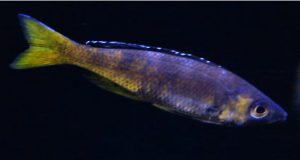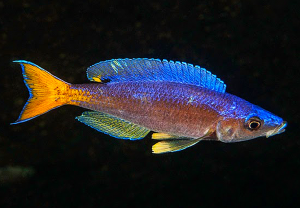The Sardine Cichlid (Cyprichromis leptosoma) known to tropical fish keeping enthusiasts as Slender Cichlid, Cyprichromis, or Slender Cyprichromis, is a small, colorful, sardine shaped open water species that is found only along the rocky eastern shoreline of Lake Tanganyika, between Kigoma in Tanzania, and Mpulugu in Zambia. They are prized by tropical fish keeping enthusiasts for their mild temperament and dazzling colors
The Sardine Cichlid is an open water species that inhabits the intermediate zones and is found throughout Lake Tanganyika in deep water areas with rocky shores, sandy bottoms, and clean water.
Cyprichromis leptosoma is a peaceful, mid water, schooling species that in the wild live in schools that number into the thousands.
In an aquarium environment, they do best in groups of at least twelve or more specimens.
There are five (blue and yellow tailed) color variants of Cyprichromis leptosoma that occur over their 300 mile range listed below, and all are gorgeous.
- Cyprichromis leptosoma “Kigoma” found around KigomaBlue-tailed males: Yellowish head with blue dorsal and anal fins.
Yellow-tailed males: Yellowish head with white dorsal and anal fins. - Cyprichromis leptosoma “KARILANI” found around Bulu Point to Kasoje (including Karilani Island)Blue tailed males: Blue dorsal fin with a yellowish tinge and a single dark ocellus at the posterior tip. Yellow orange body.
Yellow tailed males: Blue dorsal fin with no ocellus. - Cyprichromis leptosoma “IKOLA” found from Kasoje to IkolaBlue tailed males: Yellow dorsal fin.
Yellow tailed males: Blue dorsal fin and bright yellow anal fin. - Cyprichromis leptosoma “MALASA LEPTOSOMA” found froum Utinta Bay to SamaziBlue tailed males: Blue dorsal fin. Some males may have a dark ocellus visible at the posterior tip.
Yellow tailed males: Blue dorsal fin with a yellow ocellus at the posterior tip. - Cyprichromis leptosoma “MPULUNGU” found from Kasanga to MpulunguBlue tailed males: Light blue dorsal fin speckled with small, dark spots.
Yellow tailed males: Blue dorsal fin with a black band along the base
Cyps are divided into four species and two groups:
- leptosoma
Jumbo
Goldfin - microlepidotus
- pavo
- zonatus
Sardine Cichlids are virtually impossible to sex until they begin to reach breeding age, at which time they are impossible to miss. Over a period of a few months, males develop striking colors. The normal size varieties are brightly colored blue and yellow. The larger “jumbo” varieties are yellow, lavender, pastel colored and often black.
Juvenile males will begin to occasionally shimmy or shake a little before they color up, which is usually when they are around an inch in length.
Because Sardine Cichlids (Cyprichromis leptosoma) are a gregarious open water species that frequent the upper layer of the water column, they should be housed in groups of at least 8 or more individuals in a long, deep tank of at least 55 gallon capacity to provide the amount of free swimming space they require. Recommended decor inside the tank is a sandy or fine gravel substrate, with several piles of rock situated over the bottom.
Because good filtration is necessary to provide the pristine clean water they require; a wet/dry, canister
, or bio wheel
type filter is highly recommended, along with regular 20% to 30% water changes.
As a rule, Cyprichromis leptosoma are very peaceful and are often kept in a community tank environment with other Tanganyikan species that dwell in other areas of the tank. Rock or shell dwelling species like Julidochromis or Altolamprologus are good choices, but don’t house them with boisterous species like Mbuna.
Males tend to jump a lot during their spawning displays so a tight fitting aquarium cover is highly recommended.
Sardine Cichlids are easy to breed and will frequently spawn in a community aquarium, but if you plan to raise the majority of fry to adulthood, breed them in a single species aquarium environment.
Unlike many mouth brooders, Cyprichromis are best kept in groups with about the same number of males as females. Although groups of one or two males with two or three females per male also works well, and because males are much more colorful than females; you might just as well get equal numbers of males to females for your breeding tank.
Sardine Cichlids live and reproduce totally independent of the substrate, which makes them unlike any other mouth brooding cichlid species.
Place a breeding group in a wide tank as deep as possible, keep the pH at about 8.0 to 8.5, the temperature in the 75 to 85 degrees F range, and leave the fish to themselves.
The males will stake out and defend a territory in mid water and when a ripe females passes through it will display to her. If she is ready to breed, she will follow him into his territory where spawning commences.
The female lays her eggs in mid water and catches them as they are dropping in the water column. Males have egg shaped growths on the tip of their ventral fins that attract the females and when the female tries to add the “egg” growth to her brood, the male fertilizes all the eggs in her mouth.
The female will carry anywhere from 5 to 20 eggs in her mouth for up to 4 weeks before the fry are released to fend for themselves. During this period, she does not eat.
Brooding females can be easily recognized by their “chewing” action as they move the eggs around in their mouths. If left in the breeding tank, the female will deposit the fry among the rocks where a good number will survive.
At about two weeks, many breeders will strip the fry from the female’s mouth into a separate rearing tank to raise them. This approach results in a greater number of fry being raised to adulthood. However, unless you are breeding them commercially or the female is being harassed by other males, it’s best to leave her in the breeding tank with the breeding group.
The fry will eat baby brine shrimp as soon as they are released from the female’s mouth and are usually not harmed by adult Sardine Cichlids.
In their natural habitat, Cyprichromis leptosoma feed primarily on zooplankton, flying insects, insect larvae, and small crustaceans. In an aquarium environment, they do well on a diet of live, frozen, or freeze dried brine shrimp, Daphnia, freeze dried cyclops
, etc., and a quality cichlid flake
food.
Although Sardine Cichlids (Cyprichromis leptosoma) are not common, they are occasionally available in specialty fish shops but are more easily acquired from online auction sites, cichlid forums, etc. when they are approximately 1″ or more in size.
Despite the demand for this species, they are usually reasonably priced.
Minimum Tank Size: 55 gallons
Care Level: Moderate
Temperament: Peaceful
Aquarium Hardiness: Hardy
Water Conditions: 75-82° F, pH 7.8-9.0, H 10-25°
Max. Size: 4″
Color Form: Blue, Yellow
Diet: Carnivore
Compatibility: Tanganyikan Community or single species tanks
Origin: Lake Tanganyika, Africa
Family: Cichlidae
Lifespan: 8-10 years
Aquarist Experience Level: Advanced





